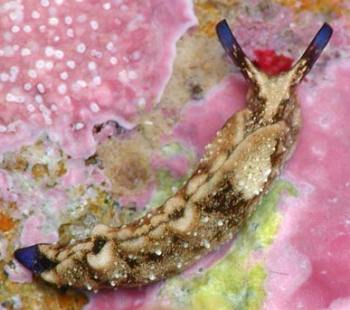
Elysia abei
Baba, 1955
Order: SACOGLOSSA
Superfamily: ELYSIOIDEA
Family: Elysiidae
DISTRIBUTION
Pacific Coast of Japan from Sagami Bay south.
PHOTO
Photos to show colour variation - from messages below. See messages for details.
See messages below discussing that Elysia abei and E. amakusana are colour forms of a single species.
Reference:
• Baba, K. (1955). Opisthobranchia of Sagami Bay, Supplement. Tokyo: Iwanami Shoten.
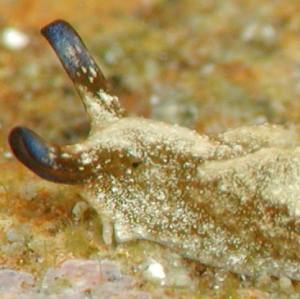
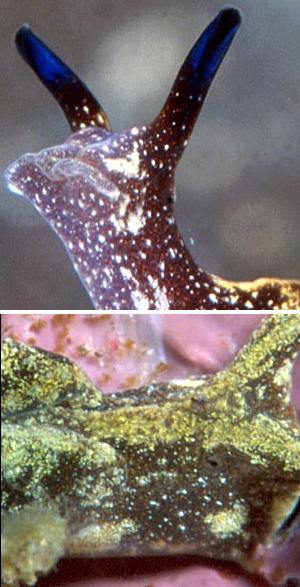
Rudman, W.B., 1999 (June 3) Elysia abei Baba, 1955. [In] Sea Slug Forum. Australian Museum, Sydney. Available from http://www.seaslugforum.net/find/elysabei
Related messages
Re: On Elysia japonica, E. abei & E. amakusana
September 14, 2002
From: Kathe R. Jensen
Dear Bill, Nishina, Jun and others,
I just returned from a field trip to Cambodia (where we released the first Cambodian sea turtle with a Japanese satellite transmitter) to find this series of photos and discussions about the identity of Elysia abei and E. amakusana. I am very happy to notice that our Japanese colleagues have reached the conclusion that they are colour forms of the same species. Now we need to decide whether this one species also includes Elysia cf. japonica from Hong Kong - and possibly also Japan. And maybe we need to convince Bill that this species is most likely Eliot's species (of course we can never be sure). Unfortunately none of these excellent pictures show the arrangement of the pericardium and dorsal vessels. This was my major reason for synonymizing the Hong Kong animals with E. japonica. The pericardium is short and with a characteristic constriction. The posteriormost pair of dorsal vessels run parallel to the foot, and the area between these vessels is more transparent in colour (probably due to absence of digestive tubules and/or reproductive ductules). I think that this will be more easy to see in preserved animals - or at least animals kept in small dishes, so the parapodia can be manipulated apart.
The tooth denticulation (absent according to Eliot, present in Baba's species and in the Hong Kong animals) is not a good character when comparing an old description to newly collected ones. Even Eliot, when redescribing E. grandifolia, noticed that the fine serrulations were only visible under the highest power.
Eliot had 18 preserved specimens of this species, and apart from E. trisinuata (which is obviously not this one), I don't think any other Elysia in Japan is that common. So, if at all possible, I would like to ask our Japanese colleagues to try and look at the pericardium and pattern of dorsal vessels.
All the best,
Kathe
jensen@ait.ac.th
Jensen, K.R., 2002 (Sep 14) Re: On Elysia japonica, E. abei & E. amakusana. [Message in] Sea Slug Forum. Australian Museum, Sydney. Available from http://www.seaslugforum.net/find/7957Thanks Kathe,
Bill Rudman
On Elysia japonica, E. abei & E. amakusana
September 13, 2002
From: Skip Pierce
Hi Bill
I don't know the species that are being discussed here, but having looked at several Atlantic (and from Hawaii) species of Elysia in aquaria for many months as we continue to study the cell biology of the captured chloroplasts, I'm of the opinion that color is not a useful tool to distinguish species amongst Elysia species with otherwise similar morphology. As you allude, color may depend a lot on what they've eaten lately. Contrary to the literature, we've found that some (but not all) species will eat all kinds of algae (and possibly bacterial films)which could effect their color - although the plastids are captured from a single algal species (although, again, some Elysia species may be able to capture plastids from more than one algal species - on which I'll publish a paper if we get enough data). Also, generally, brown colored Elysia are those who are nearing the end of their life cycle and have lost their plastids - sort of like a leaf on a tree (homage to Trench) in the fall [autumn] - some will "re-green" if provided the correct algal species. Many species of Elysia have tiny red (and also blue) pigment clusters when you look closely. I don't know what the clusters are - nice master's thesis project there, but maybe someone else has looked at it already. Other species of Elysia turn yellow when they lose their chloroplasts and many years ago, Bleakney reported E. chlorotica "ghosts" which were white when not fed, but which we cross-bred with green E. chlorotica - thus likely the same species, just can't take up the chloroplasts. So, color may not be a reliable characteristic in Elysia spp. The answer to all these relationships will eventually be found from molecular evidence, of course, but the pictures are great in the meantime.
Hope you enjoyed your break.
Skip Pierce
Professor and Chair
Department of Biology
University of South Florida
Tampa, FL
pierce@chuma1.cas.usf.edu
Pierce, S., 2002 (Sep 13) On Elysia japonica, E. abei & E. amakusana. [Message in] Sea Slug Forum. Australian Museum, Sydney. Available from http://www.seaslugforum.net/find/7932Thanks Skip,
These sacoglossans are fascinating beasts. I have previously referred to Brian Brandley's 1984 study on an Elysia species here is Sydney which he showed changed food and plastids and hence colour during it life cycle, so its great to hear that you are making similar observations. I agree that colour in Elysia is a difficult character to use but I suspect many of these species can be identified as 'species' at the local level even if names are difficult to apply. People working with local populations soon get a 'feel' for similarities and differences. They are not always right, but with a little confirmation from the anatomy, it is not that difficult to get to know the range of colour and shape variation that exists in local populations. Until we have a better idea on variability within local populations I think it is very difficult to say anything sensible about variability on a wider geographic scale. That is why I welcome photos on the Forum showing colour variation in even the most common animals.
I hope your present research yields results, and look forward to reading about them in the future
Best wishes,
Bill Rudman
Elysia abei and E. amakusana
September 13, 2002
From: Yoshiaki J. Hirano
Dear Bill,
Concerning the recent topics on species identities of Elysia abei and E. amakusana, my student and I have reached the same conclusion that they are probably conspecific. We have been working on the two forms to find out what is responsible for the colour difference. Yes, the two readily copulate, we have confirmed it. We are hoping to present the result at the next meeting of the Malacological Society of Japan.
Best wishes,
Yoshi
hiranoyj@earth2.s.chiba-u.ac.jp
Hirano, Y.J., 2002 (Sep 13) Elysia abei and E. amakusana. [Message in] Sea Slug Forum. Australian Museum, Sydney. Available from http://www.seaslugforum.net/find/7950Dear Yoshi,
Thanks for letting us know. I look forward to seeing your work published. It will be good to see some evidence.
Best wishes,
Bill Rudman
Colour forms of E. abei (1)
September 9, 2002
From: Nishina Masayoshi
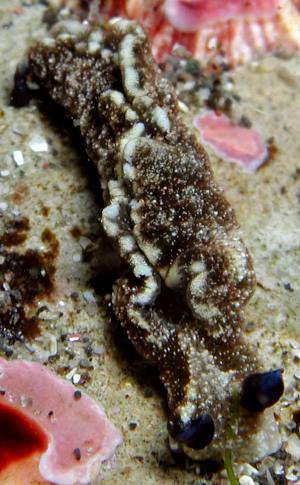
Dear Bill,
To accompany my main discussion on E. abei and E. amakusana, here is a particularly dark brown variety which I was previously calling E. amakusana in your forum is correct. This animal is common in Sagami Bay and Izu Peninsula, Japan. The smalll red or orange small specks on the inside and outside of parapodia are quite noticeable in this colour form. The length of the animal is averagely 10mm to 15mm so it's impossible to see the specks without magnifying lens. The dorsal color range of the 'E. amakusana' form is from dull brown or dull cream-brown to dull green.
Best Regards,
Nishina Masayoshi
nishina@wips.co.jp
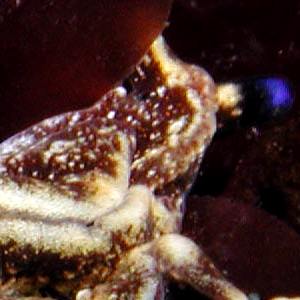
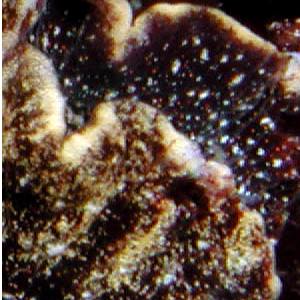
Thanks Nishina,
Bill Rudman
On Elysia japonica, E. abei & E. amakusana
September 9, 2002
From: Nishina Masayoshi
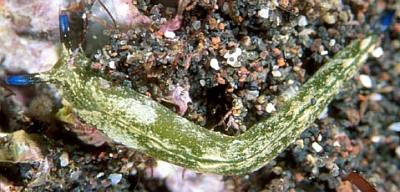
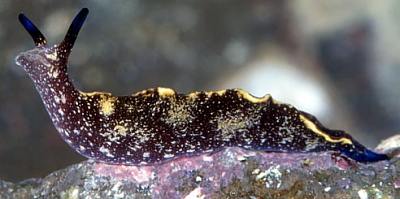
Note: Over the last few weeks Nishina Masayoshi has been discussing with me his ideas about these species of Elysia, in particular, E. abei and E. amakusana. His final conclusion is that these 2 'species' are colour forms of the same species. One of the distinctive features of this species are small reddish spots all over the body and sole of foot. Presenting this sort of discussion clearly in English is difficult for an English speaker to do, so what follows is a summary of Nishina's thoughts prepared by me - Bill Rudman.
PHOTOS: Hisako Yamada.
Dear Bill,
Finally, I have clarified my thoughts on E. abei and E. amakusana. I think some of the confusion has been caused because the English section of Baba (1949) [Opisthobranchs of Sagami Bay] is often a rather poor translation of the Japanese.
Here are my translations of the external features from the Japanese:
• Elysia japonica from Baba 1949 [Opi. Sagami Bay - 1st edition]: Grows to 2 cm. The parapodia is narrow. Sometimes, a small number of papillae are scattered on the outside of the parapodia. A corner of the anterior edge of the foot is rather square. The dorsal color is Azuki bean color (reddish brown or dark reddish beige). The features of this animal are, the rhinophores and the tip of the tail are dark violet. Note: this is not Eliot's Elysia japonica. Kathe Jensen has identified Eliot's species as the one I have on the Forum as E. cf. japonica
• Elysia amakusana: In Baba (1955) [Supplement to Opi. Sagami Bay] Baba, renames his Elysia japonica with the new name Elysia amakusana:
"I update the name of E. japonica in Opi. Sagami Bay pp.35, 131; Pl, IX, fig. 27; Text-fig. 25 to E. amakusana Baba. Eliot in describing his E. japonica had only preserved specimens and did not know where they were collected. Although both Eliot's and Baba's 'E. japonica' have black rhinophores and a black-tipped tail, the radular morphology is different."
• Elysia abei: In Baba (1955) [Supplement to Opi. Sagami Bay] Baba, renames his Elysia viridis with the new name Elysia abei. This is complicated however because he considers that he misidentified 2 species as Elysia viridis in 1949.
"I consider the animal shown in Opi. Sagami Bay Pl. VIII, fig.26 in which the rhinophores and the tip of the tail are dyed black ... and with many fine red-vermilion specks scattered on the surface of the body (head, dorsolateral, inside and outside of parapodia and surface of the foot) .. to be another distinct species. Therefore I give a new name Elysia abei". [The animal he identified as Elysia viridis - Opi. Sagami Bay, Pl. VIII, fig.25 - he renames E. hirasei in 1955].
In the reprinted version of Opi. Sagami Bay Baba, (1990) there is a list of updated nomenclature. In this he lists:
E. abei = E. japonica or E. abei (Opi. Sagami Bay,1949, pl.8, fig.26)
E. amakusana = E. japonica or E. amakusana (Opi. Sagami Bay, 1949, pl.9, fig.27).
What do you think? They both have blue and black tips to the rhinophores and tail and the radula morphology is identical. My friends and I used to think that E. abei could be distinguished by the red specks. But we have looked closely at the brown E. amakusana and it also has them, though they are more difficult to see. I have sent as separate messages, photos of a number of different colour forms of this species. As both names were published together, which is the synonym?
Best Regards,
Nishina Masayoshi
nishina@wips.co.jp
Masayoshi, N., 2002 (Sep 9) On Elysia japonica, E. abei & E. amakusana. [Message in] Sea Slug Forum. Australian Museum, Sydney. Available from http://www.seaslugforum.net/find/7784
Dear Nishina,
Thanks for all the photos and time that you and your friends have spent considering this question. I have included the closeup photos, showing the reddish spots, alongside.
Upper: Photo - Hisako Yamada.
Lower: Photo - Nishina Masayoshi.
It is unfortunate that so many species have been described from single specimens, or even decolourised preserved specimens. Elysia japonica is a good example of a species described from preserved specimens. I suspect we will never be totally sure of its identity.
Looking at the photos in this message and your other messages, I agree that this seems to be an example of one variable species. It would be interesting to see whether there is any pattern in the colour forms. Are the brown and green ones on different algae? Are there eggs the same? Do the various colour forms mate with each other?. Before I move all the messages from the E. amakusana page it would be interesting to hear Kathe Jensen's views on the subject. It does seem, however, that Shigeru Hayashi's animals are probably what we are calling Elysia cf. japonica.
Concerning whether we should use E. abei or E. amakusana, I will first have to look at the 1990 reprint of Sagami Bay to see whether Baba actually addressed this question. Under the International Rules it is really up to the first reviser to decide. At present websites such as the Forum are not considered 'publications' for nomenclatural purposes, but since E. abei appears first in Baba, 1955 think it is appropriate to use that name.
Best wishes,
Bill Rudman
Colour forms of Elysia abei (2)
September 9, 2002
From: Nishina Masayoshi

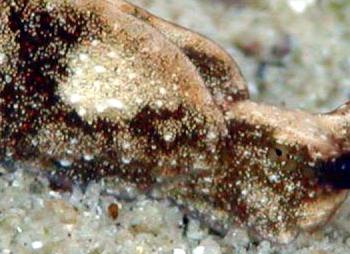
Dear Bill,
To accompany my main discussion on E. abei and E. amakusana here are some photos of a pale brown form.
UPPER: Shimoda, Sagami Bay, Japan. 24 August 2002. Photo: J.Imamoto
LOWER: Echizen coast, Japan. 3 August 2002. Photo: J.Imamoto
I asked Jun Imamoto to confirm the colour details of this animal. He could see the vermilion-red specks. When the body color is redder, then the specks are even harder to see.
Nishina Masayoshi
nishina@wips.co.jp
Masayoshi, N., 2002 (Sep 9) Colour forms of Elysia abei (2). [Message in] Sea Slug Forum. Australian Museum, Sydney. Available from http://www.seaslugforum.net/find/7842Thanks Nishina,
Bil Rudman
Colour forms of Elysia abei (3)
September 9, 2002
From: Nishina Masayoshi

Dear Bill,
To accompany my message about E. abei and E. amakusana here are some photos of another colour form from Jun Imamoto.
I can easily to see the vermilion red specks on a darker body but it is difficult to the specks on a lighter one as illustrated here. I hope you can see it.
Date: 24 Aug 2002
Loc: Shimoda, Izu. Japan
Lengh: 10mm
Depth: 0.5m
Photo: J.Imamoto
Best Regards,
Nishina Masayoshi
nishina@wips.co.jp

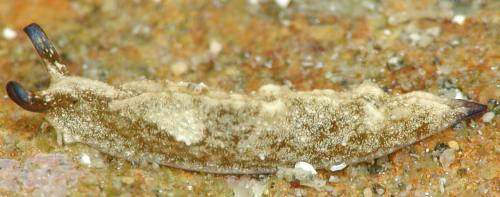
Thanks Nishina,
Bill Rudman
Colour forms of Elysia abei (4)
September 9, 2002
From: Nishina Masayoshi
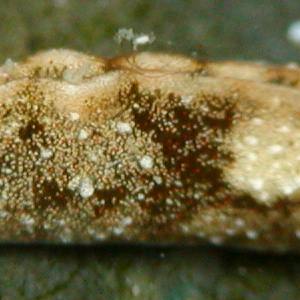
Dear Bill,
To accompany my message about E. abei and E. amakusana here are some photos of another colour form from Jun Imamoto.
The vermilion red specks are quite easy to see on this darker body but it is difficult to see the specks on a lighter one.
Date: 24 Aug 2002
Loc: Shimoda, Izu. Japan
Lengh: 10mm
Depth: 0.5m
Photo: J.Imamoto
Best Regards,
Nishina Masayoshi
nishina@wips.co.jp

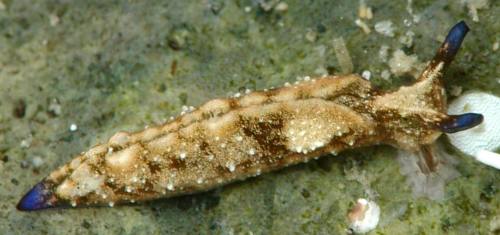
Thanks Nishina,
Bill Rudman
Re: Elysia abei from the Japan Sea
September 23, 1999
From: Cynthia Trowbridge
Dear Shigeru Hayashi,
I am extremely interested to see your photos of Elysia abei. I have been trying to learn the Japanese species of sacoglossans after visiting with Dr. Yoshi Hirano and his wife at Kominato Marine Lab in July. In your message, you mentioned the second edition of Baba's book on Opisthobranchs; I would be very grateful to learn of the full citation of the work. Also, if your group had a colour photo of E. atroviridis, could you send one to the Forum please? I would be particularly interested in seeing what that species looks like when alive. Thank you!
Cordially,
Cynthia Trowbridge
trowbric@ucs.orst.edu
Trowbridge, C., 1999 (Sep 23) Re: Elysia abei from the Japan Sea. [Message in] Sea Slug Forum. Australian Museum, Sydney. Available from http://www.seaslugforum.net/find/1362Dear Cynthia,
It would certainly be very useful to see some photos of even the most common Japanese sacoglossans.
Concerning Baba's Second Edition. It is a boxed set containing facsimile copies of Sagami Bay, 1949, and the 1955 Supplement. There is a list (but no discussion) at the back of each volume where Baba compares his original nomenclature with that which he considers appropriate today. I have just looked through our copy and can't find an appropriate citation for the facsimile edition, though it may be in the Japanese section. The publisher, Iwanami Shoten, is the same.
Best wishes,
Bill Rudman.
Elysia abei from the Japan Sea
September 22, 1999
From: Shigeru Hayashi
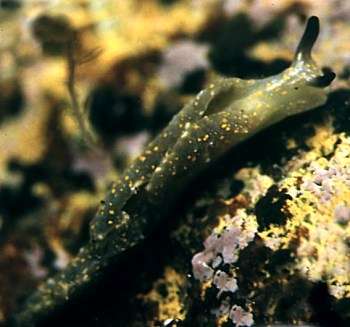
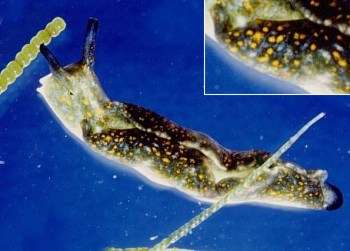
Hello Bill Rudman
Here is our first contribution of Sea Slugs from The Japan Sea.
I think that the Elysia? which was reported by Mr. Ono from Kerama Is is not Elysia abei Baba, 1955(s.s.).
This species is reported from Toyama Bay and is named for my teacher, T. Abe. Elysia abei is mentioned with Elysia amakusana Baba, 1955(s.s.) and Elysia japonica Eliot, 1913 (in the broad sense) in Dr. Baba's 'Opisthobranchia of Sagami Bay Supplement' (Second edition 1990).
It was collected, from the 2 m water depth on August 3, 1985, the body length of 15 mm, in Toyama Bay, Amaharashi on the algae Chaetomorpha. The second photo is of another specimen, the body length of 20mm, 2m water depth on August 12, 1998 in Toyama Bay, Akasaki.
In the coasts of the Central Japan Sea, this species can be generally observed and it has been recorded 228 times since 1950.
Sincerely yours
Shigeru Hayashi
Takaoka Biological Club
jr9dsx@tko.fitweb.or.jp
Hayashi, S., 1999 (Sep 22) Elysia abei from the Japan Sea. [Message in] Sea Slug Forum. Australian Museum, Sydney. Available from http://www.seaslugforum.net/find/1360Dear Shigeru,
Thanks very much for the information and photos of Elysia abei. I can see now that it is quite different from Atsushi Ono's animal. If you have photos of other Japanese Elysia and sacoglossans I would be very interested, as colour photos are a much easier way to see similarities and differences than written descriptions, even when they are detailed and meticulous.
Best wishes,
Bill Rudman.
